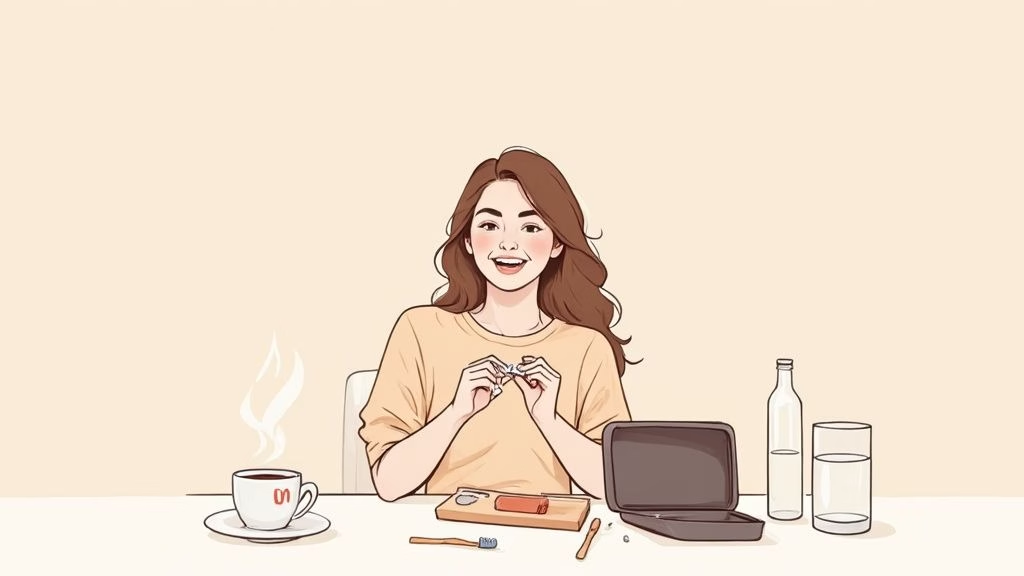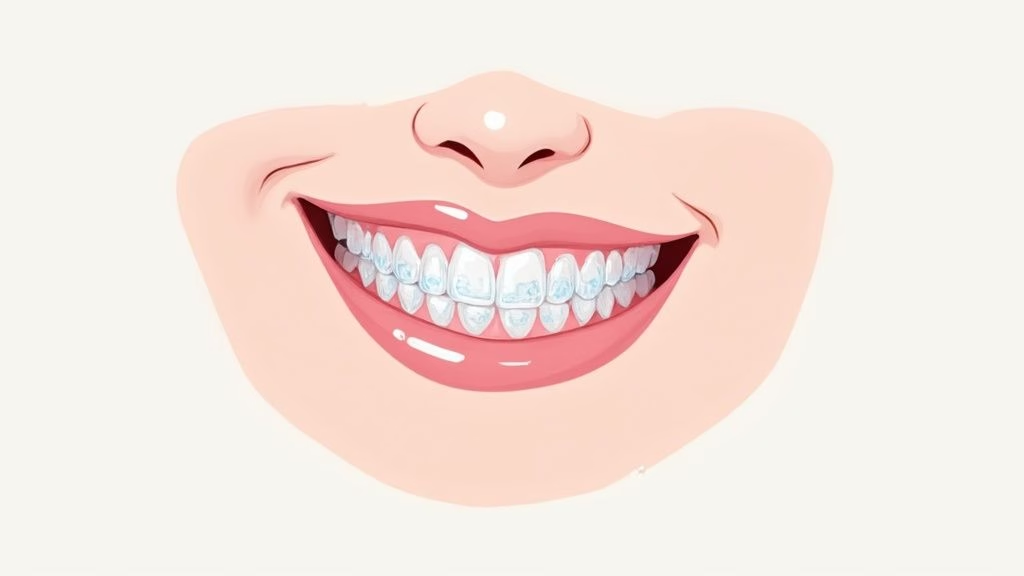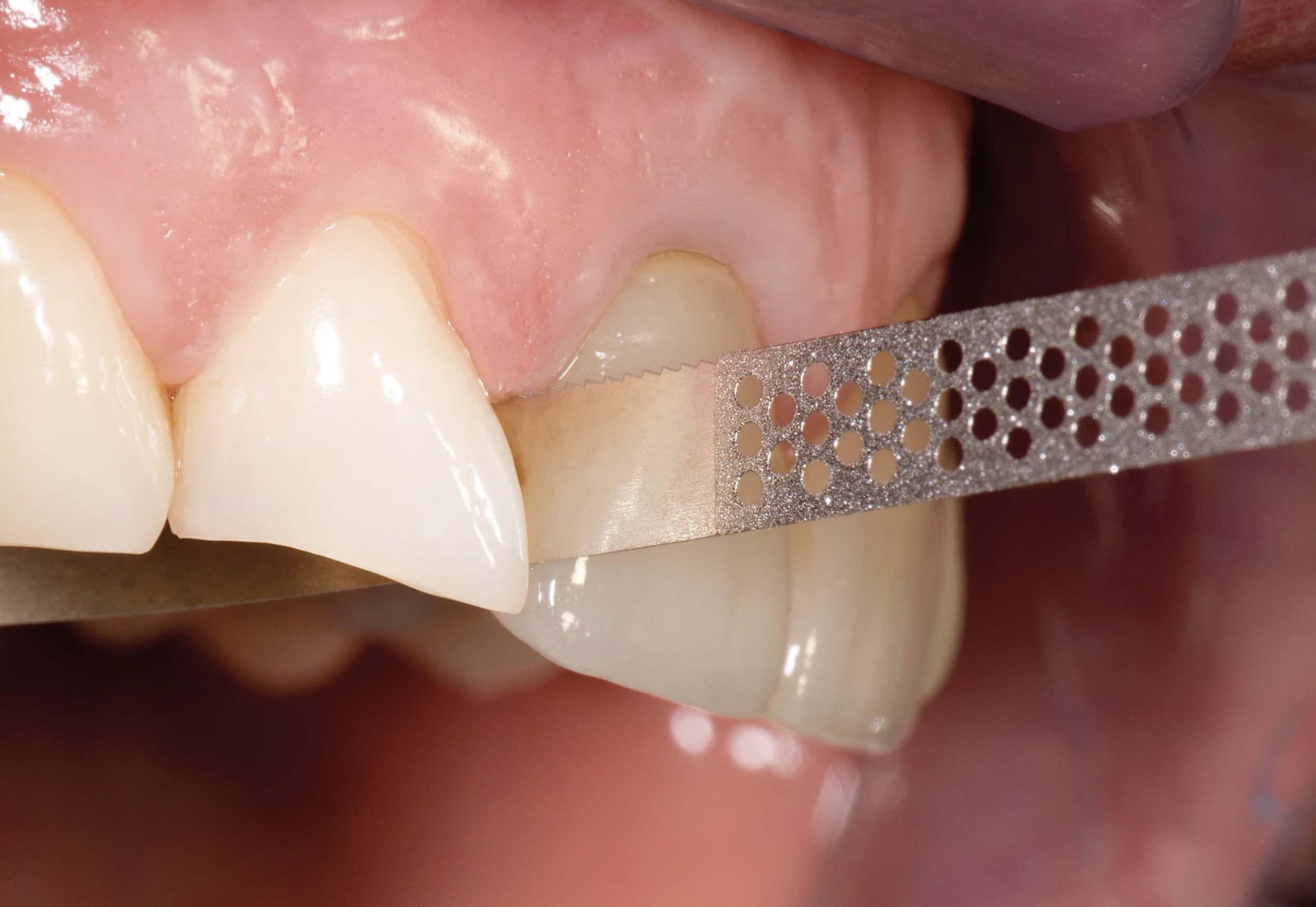What Is Orthodontic Treatment and How Does It Work
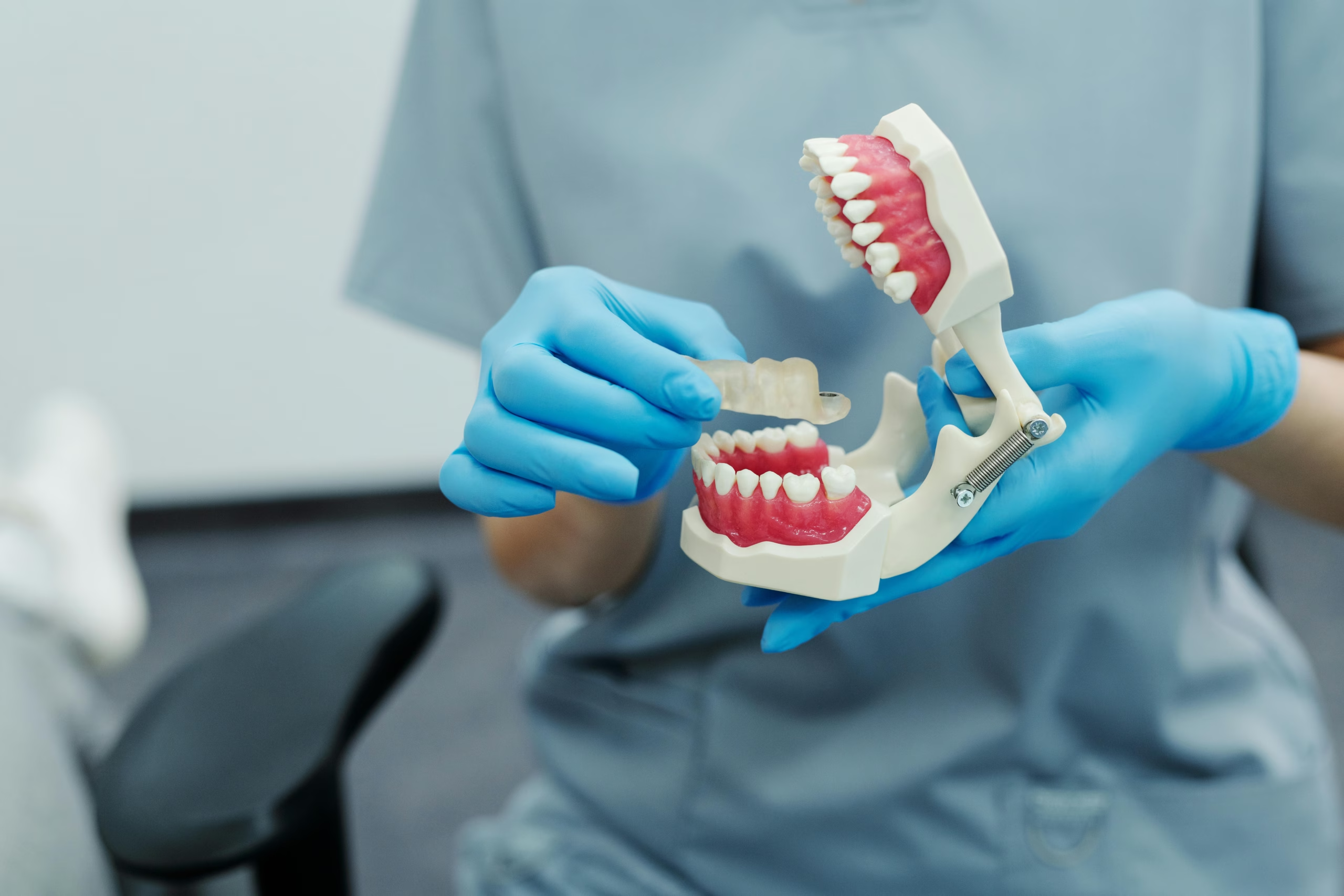
Orthodontic treatment is a specialised field of dentistry dedicated to correcting teeth and jaws that are out of place. It’s far more than just a cosmetic fix; it’s about carefully guiding your teeth into their ideal positions to improve how your mouth functions and enhance your overall oral health. The end goal is a smile that’s not only beautiful but also healthy and works as it should.
The Foundation of a Healthy Smile
Imagine your teeth and jaw as a complex piece of machinery. When teeth are crooked, crowded, or the bite doesn’t line up properly, the gears don’t mesh correctly. This misalignment can cause a whole host of problems that go way beyond simple appearances. The core purpose of any orthodontic treatment is to bring balance and harmony back to this intricate system.
This isn’t a niche concern, either. Orthodontics is a cornerstone of dental health services across the UK. In just one recent year, NHS dentists in England carried out around 35 million courses of dental treatment, and a huge part of that was orthodontic work for both young people and adults.
To get a clearer picture, let’s break down what orthodontic treatment really involves.
Orthodontic Treatment At A Glance
| Aspect | Description |
|---|---|
| Primary Goal | To correct misaligned teeth and jaws for improved function and aesthetics. |
| Common Issues Addressed | Crooked teeth, overcrowding, gaps, overbites, underbites, and crossbites. |
| Typical Duration | Varies from 6 months for minor corrections to 24+ months for complex cases. |
This table gives a quick overview, but the benefits run much deeper than just straightening teeth.
More Than Just Cosmetics
While getting a beautiful smile is a fantastic result, the functional improvements are just as crucial. Straight teeth are significantly easier to brush and floss, which lowers your risk of tooth decay and gum disease. A properly aligned bite also means chewing forces are distributed evenly, preventing premature wear on your teeth and sometimes even easing jaw pain.
Orthodontics is a proactive investment in your long-term health. It addresses the root cause of many dental issues, rather than just treating the symptoms.
Thankfully, modern techniques have made the journey to a straighter smile easier than ever. Companies like Toothfairy are introducing smarter, more affordable ways to straighten teeth. These clear aligners can fit neatly into a busy lifestyle, offering a convenient choice compared to other well-known aligner brands. Ultimately, understanding what orthodontic treatment is means seeing it for what it truly is: a powerful tool for boosting both your confidence and your long-term dental wellbeing.
Why Straight Teeth Are Healthier Teeth
Most people think orthodontic treatment is all about getting that picture-perfect smile. While that’s certainly a great outcome, the real benefits run much deeper than just appearances. Properly aligned teeth are a fundamental part of your long-term oral health, working together like a perfectly tuned engine. This isn’t just about looks; it’s about function and prevention.
When your teeth are straight, they’re simply easier to keep clean. It makes sense when you think about it: crooked or crowded teeth create all sorts of awkward little hiding spots for plaque and food particles. Your toothbrush bristles and floss just can’t get into those nooks and crannies effectively.
These hard-to-reach areas are breeding grounds for tooth decay and gum disease. By straightening your teeth, you eliminate these hiding places, making your daily hygiene routine more effective and dramatically cutting down your risk of future dental problems. It’s why understanding what orthodontic treatment is means seeing it as an investment in your health, not just a cosmetic touch-up.
Beyond a Pretty Smile: The Health Perks
The advantages of a properly aligned bite don’t stop at your gums. The benefits extend right into the very structure of your mouth and jaw. Misaligned teeth don’t just look a bit messy; they can throw off the entire balance of how you bite and chew.
Over time, this imbalance can trigger a whole host of related health issues:
- Reduced Tooth Wear: With a correct bite, the force from chewing is spread evenly across all your teeth. When teeth are out of line, a few of them end up taking on far more pressure than they were designed for, leading to premature wear and tear, chips, and even fractures.
- Improved Gum Health: Crowded teeth can push your gums into unnatural positions, leaving them vulnerable to inflammation and infection. Straight teeth allow the gums to fit snugly around them, forming a much stronger barrier against periodontal disease.
- Alleviation of Jaw Pain: An improper bite can put a huge strain on the temporomandibular joints (TMJ) – the hinges connecting your jaw to your skull. This can lead to chronic headaches, a clicking or popping jaw, and real discomfort, all of which can often be improved with orthodontic treatment.
“Leaving misaligned teeth untreated may lead to other dental problems such as tooth decay, gum disease, abnormal wearing of tooth enamel and difficulty chewing.”
This really gets to the heart of it. Orthodontics tackles the root cause of many common dental complaints. With smarter and more affordable options like Toothfairy, accessing these health benefits is easier than ever, avoiding the high costs often associated with some specific aligner brands.
By correcting your bite, you’re doing so much more than just improving your smile. You’re setting yourself up for a lifetime of better oral health, greater comfort, and a serious boost in confidence. That’s the real power of orthodontic care.
Modern Ways to Straighten Your Smile
If you’ve decided it’s time to straighten your teeth, you’ll find that the world of orthodontics has come a long way. The days of having one single, very conspicuous option are long gone. Today, there’s a whole range of treatments designed to suit different lifestyles, budgets, and, of course, how you want to look during the process.
At their core, all orthodontic treatments work on the same principle: applying gentle, consistent pressure to move your teeth into their ideal positions. It’s how they achieve this that sets them apart. Getting to grips with these differences is the key to choosing the right path for you.
Traditional Braces: The Tried-And-True Method
When most people hear the word “orthodontics,” traditional braces are what immediately spring to mind. They’re the classic setup of metal or ceramic brackets bonded to each tooth, all connected by a thin archwire. Your orthodontist periodically tightens this wire, which is what guides your teeth into alignment over time.
There’s no denying their effectiveness, especially for very complex bite issues. But this method does have its downsides. The brackets and wires are noticeable and come with a list of foods you need to avoid so you don’t break them. For many adults, that’s just not practical for a professional or social life.
You’ll find a few different types:
- Metal Braces: The most common and robust option, well-known for their strength and efficiency.
- Ceramic Braces: These work the same way but use tooth-coloured or clear brackets, making them less obvious. They can be a bit more fragile and are prone to staining.
- Lingual Braces: The ultimate in discretion, as they’re fitted to the back of your teeth. This makes them completely hidden, but they tend to be more expensive and can take some getting used to.
Clear Aligners: The Modern, Flexible Alternative
Clear aligners have completely changed the game, offering a discreet and convenient way to get a straighter smile. Instead of fixed brackets and wires, you wear a series of custom-made, transparent plastic trays that fit perfectly over your teeth. You wear each tray for a week or two before switching to the next one, with each set bringing you a little closer to the final result.
Their biggest advantage? They’re removable. You can take them out to eat, drink, and brush your teeth, which means no dietary restrictions and a much easier time keeping your teeth clean. This simple feature has made them incredibly popular, especially with adults who need a solution that fits into their busy lives.
Patient priorities are shifting. A UK survey found that while people trust the quality an orthodontist provides, a significant 25% prefer the convenience of direct-to-consumer aligners. It shows a real demand for treatment that is both effective and easy to manage. You can read more about these orthodontic preferences.
This is precisely why services like Toothfairy have become such a smart solution. By offering dentist-prescribed clear aligners with at-home monitoring, they give you the professional oversight of traditional orthodontics combined with the modern convenience people are looking for. It’s a smarter and more affordable approach that cuts out the high overheads and frequent in-person appointments of other brands, making a straighter smile more accessible than ever before.
Comparing Orthodontic Treatment Methods
Choosing between braces and aligners can feel like a big decision. This table breaks down the key differences to help you see which option might be a better fit for your lifestyle and goals.
| Feature | Traditional Braces | Clear Aligners (e.g., Toothfairy) |
|---|---|---|
| Appearance | Noticeable metal or ceramic brackets and wires. | Virtually invisible, clear plastic trays. |
| Comfort | Can cause initial discomfort and irritation to cheeks and gums. | Smooth plastic, generally more comfortable. |
| Convenience | Fixed in place; cannot be removed by the patient. | Removable for eating, drinking, and cleaning. |
| Dietary Restrictions | Yes—avoid hard, sticky, and chewy foods to prevent damage. | No—you can eat and drink whatever you like. |
| Oral Hygiene | Can be challenging to clean around brackets and wires. | Easy—simply remove the aligners to brush and floss as normal. |
| Treatment Time | Typically 18-24 months, but varies depending on complexity. | Often faster for mild to moderate cases, sometimes 4-6 months. |
| Clinic Visits | Requires regular in-person appointments for adjustments. | Fewer in-person visits, with progress often monitored remotely. |
| Best For | Complex cases, including severe bite issues and rotations. | Mild to moderate crowding, spacing, and alignment issues. |
Ultimately, both traditional braces and modern clear aligners like those from Toothfairy are excellent tools for achieving a healthier, more confident smile. The best choice really comes down to your specific dental needs, your budget, and what you value most in a treatment experience—be it the power to handle complex issues or the freedom and flexibility of a removable system.
Your Orthodontic Treatment Journey, Step by Step
Deciding to start orthodontic treatment is a fantastic first step towards boosting your health and confidence. It can feel like a big commitment, but understanding what to expect can make the whole process feel much less daunting. Think of it as a clear, manageable roadmap to a better smile.
While every patient’s plan is unique, the journey itself follows a well-trodden path. It all starts with a thorough assessment and ends with the big reveal of your new, straighter teeth. This isn’t just about putting on braces; it’s a carefully crafted process designed around your specific dental needs and what you hope to achieve.
The Initial Consultation
Everything kicks off with your first consultation. This is your chance to sit down with your dentist, talk about the changes you’d like to see, and ask all your questions. They’ll carry out a full examination of your teeth, jaw, and how you bite together to get a clear picture of your current situation.
To create a truly accurate plan, they’ll need some diagnostic records. Traditionally, this meant X-rays and gooey, uncomfortable putty impressions. Thankfully, many modern practices, like Toothfairy, now use advanced digital 3D scans. These create a precise digital model of your mouth, making the start of your treatment far more comfortable and accurate.
The following infographic gives a great overview of the typical flow, from that first chat right through to keeping your new smile in place for the long haul.
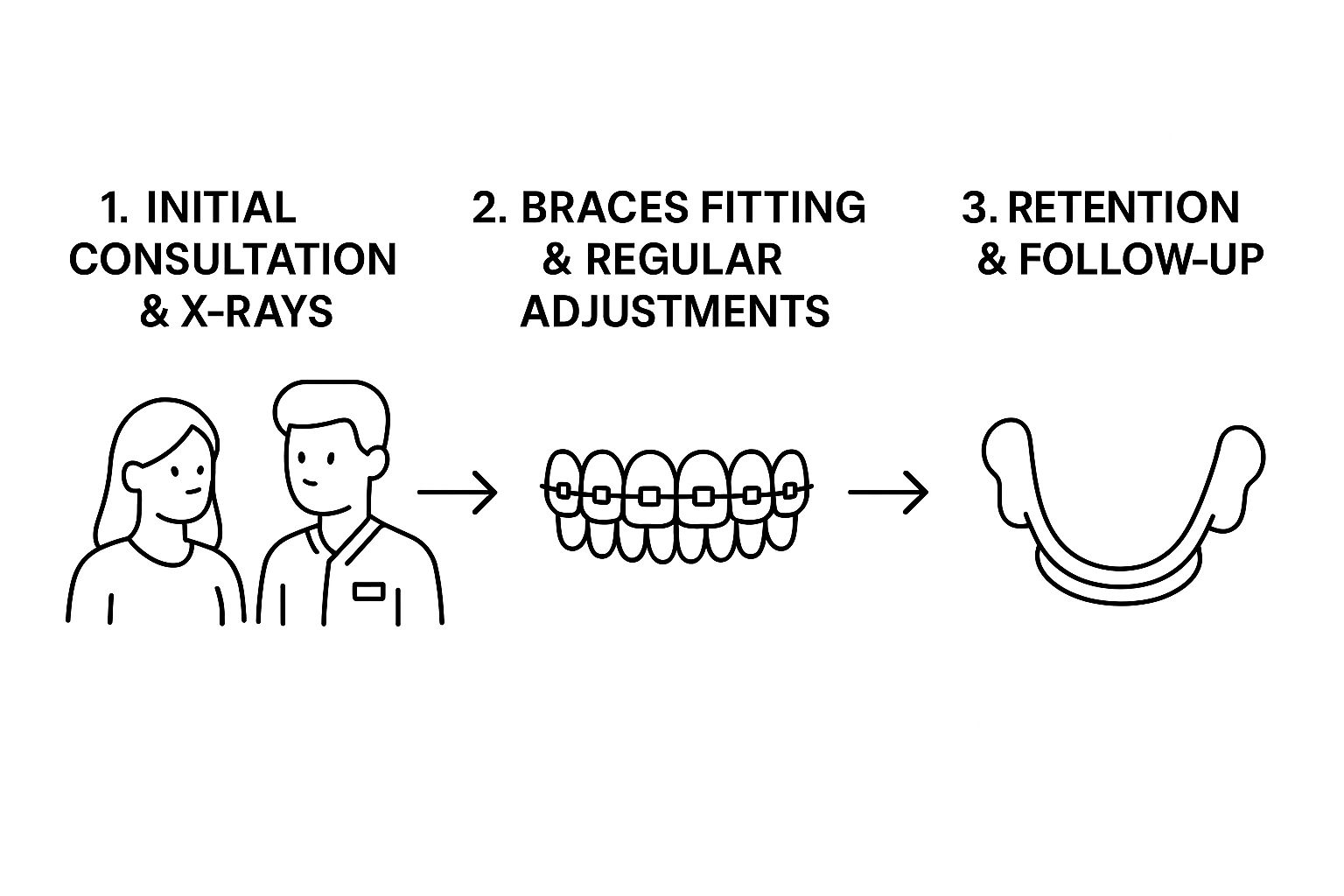
As you can see, orthodontic treatment is a structured process with clear stages. Each one builds on the last to make sure you get a fantastic, lasting result.
The Active Treatment Phase
With your custom plan in place, it’s time for the “active” phase to begin. This is where the teeth start moving.
If you’ve gone for traditional braces, this involves your dentist fitting the brackets to your teeth. You’ll then come back for regular check-ins where they’ll make small adjustments, gently guiding your teeth into their ideal positions.
For anyone using clear aligners, you’ll be given a series of custom-made trays. The idea is simple: you wear each set for about one to two weeks before switching to the next one in the series. It’s during this stage that the real work happens, as your teeth gradually shift with each new aligner.
No matter which option you choose, your commitment is the key to success. For aligner users, this means wearing them for the recommended 20-22 hours per day. If you have braces, it’s all about keeping up with excellent oral hygiene around the brackets and wires.
Retention: The Final—and Most Crucial—Step
Once your teeth are perfectly aligned, your braces or aligners come off. But the journey isn’t quite finished yet. Welcome to the retention phase, which is arguably the most important step for making sure your results last a lifetime.
To stop your teeth from moving back, you’ll be fitted with a custom retainer. Its job is to hold your newly straightened teeth in place while the surrounding bone and gums get used to the new layout. Without it, teeth have a natural tendency to drift back towards where they started.
Consistent wear, especially in the first few months, is absolutely vital. Think of it as protecting your investment and ensuring you can enjoy that brilliant new smile for many years to come.
Who Is a Good Candidate for Orthodontic Treatment?
There’s a persistent myth that braces are just a rite of passage for teenagers. The truth? Healthy teeth can be gently guided into place at pretty much any age. So, whether you’re a teen or a full-fledged adult, the door to a healthier, more confident smile is wide open.
For younger patients, it’s often about getting ahead of the game. An orthodontist can spot and fix potential problems like a developing overbite or serious crowding while the jaw is still growing. This kind of early intervention can sidestep more complex issues later on, really setting a child up for a lifetime of good oral health.
It’s Not Just for Teenagers Anymore
We’ve seen a huge increase in adults seeking orthodontic treatment, and it’s easy to see why. Many are finally taking the chance to fix long-standing issues they’ve been conscious of for years, from crooked teeth to frustrating gaps. In fact, today one in three orthodontic patients is over the age of 18. It’s never too late to invest in your smile.
So, what brings adults to the orthodontist’s chair?
- A desire for a more polished, professional-looking smile to boost confidence.
- To correct an “orthodontic relapse”—when teeth have shifted back after treatment in their youth.
- Making teeth easier to clean by straightening out crowded areas.
- Paving the way for other cosmetic work, like veneers or dental implants.
Orthodontic treatment works just as well for adults as it does for kids because the basic biology of moving teeth doesn’t change. The main difference is that adult jawbones are denser, which just means treatment might take a little longer.
Finding a Treatment That Fits Your Life
The surge in adult orthodontics is definitely linked to the arrival of more discreet and flexible options. For many working professionals, the thought of traditional metal braces is simply a non-starter. This is where modern clear aligners have completely changed the game.
Smarter, more accessible solutions like Toothfairy provide clear aligners that blend right into a busy adult lifestyle. They’re virtually invisible and can be popped out for important meetings or meals, giving you a level of freedom that older methods just can’t offer. This convenience is a big deal, especially when you look at the long waits for traditional care. A recent NHS audit in England, for example, found 141,487 children had been waiting over a year just for an assessment. This really highlights the need for alternatives, and you can discover more insights about orthodontic waiting lists and their impact.
At the end of the day, whether you’re a teenager with developing alignment issues or an adult ready to get the smile you’ve always dreamed of, there’s a very good chance you’re a great candidate for orthodontic treatment.
Keeping Your New Smile for Life
Getting your braces off or finishing your last aligner tray feels like crossing a finish line. It’s a huge milestone, but your orthodontic journey isn’t quite over. Now comes the final, and arguably most important, stage: retention. This is how you protect the incredible results you’ve worked so hard to achieve.
Your teeth aren’t set in concrete. They’re held in your jaw by tiny ligaments that have a kind of “memory” of where they used to be. Without something to hold them in their new, corrected spots, they’ll naturally try to drift back. This is where your retainer steps in, acting as a gatekeeper to make sure your smile stays put while everything settles down.
Your Retainer is Your Smile’s Best Friend
Think of your retainer as the insurance policy for your investment. Its one and only job is to hold your teeth in their perfect new alignment, stopping any unwanted movement in its tracks.
Right after your treatment, your orthodontist will probably ask you to wear it full-time. Don’t worry, this isn’t forever! Over time, this usually tapers down to just wearing it at night while you sleep.
Being consistent is the name of the game, especially in those first few months. Even skipping a night here and there can give your teeth a chance to shift, potentially undoing some of the hard work. To keep your retainer doing its job for years to come, a little care goes a long way:
- Clean it every day: Just like your teeth, your retainer can get covered in plaque and bacteria. Give it a gentle brush with a soft toothbrush and some non-abrasive cleaner.
- Keep it safe: When it’s not in your mouth, your retainer belongs in its case. This simple habit will save it from being lost, stepped on, or even chewed up by a curious pet.
- Handle with care: Be gentle when putting it in and taking it out. And never, ever use hot water to clean it, as the heat can warp the plastic and ruin the fit.
Looking after your new smile is a lifelong commitment. Your retainer is the single most important tool you have to make sure the time, effort, and money you put into your treatment pays off for good.
Of course, maintaining your results also means keeping up with great oral hygiene. Brushing and flossing are just as vital now to keep your gums healthy and your teeth free from decay. Don’t forget to keep up with your regular dental check-ups, either.
By embracing this final phase with the same dedication you gave your treatment, you can be sure you’ll be enjoying that confident, straight smile for many, many years to come.
Your Top Orthodontic Questions Answered
Taking the first step towards a straighter smile is a big decision, and it’s completely normal to have a few questions buzzing around your head. Most people wonder about the cost, how long it will take, and whether it’s going to be uncomfortable. Let’s clear up some of those common queries so you can feel confident about moving forward.
The cost of orthodontic treatment can vary quite a bit, depending on how much work your teeth need and the type of treatment you go for. Traditional braces can be a significant investment, and some of the big-name clear aligner brands carry a hefty price tag too. But thankfully, modern approaches like Toothfairy are making things more affordable by using smart remote monitoring to cut down on costs, bringing a straighter smile within reach for more people.
How Long Will It Take and Will It Hurt?
Most orthodontic journeys take somewhere between 12 to 24 months to complete. However, if you have a more straightforward case, clear aligners can sometimes work their magic in as little as six months. After your first consultation, you’ll get a personalised treatment plan that maps out your specific timeline.
Now, for the big question: comfort. It’s a common worry, but genuine pain is very rare. You might feel a bit of mild pressure or tenderness, especially after an adjustment or when you pop in a new set of aligners for the first time. This is totally normal. Today’s orthodontic appliances are designed to be as gentle as possible, using a steady, light force to guide your teeth into place.
Just remember, that slight ache is a sign that things are moving in the right direction. It’s a temporary feeling and a small trade-off for a lifetime of better oral health and a smile you love.
Getting to grips with the basics really helps take the mystery out of the whole process, making it all feel a lot less intimidating.
Ready to take the next step towards the smile you’ve always wanted? With Toothfairy, achieving a healthier, straighter smile is simpler and more affordable than you might think. We also offer solutions for dental emergencies and cosmetic dental work. Learn more and get started on your journey with Toothfairy today!
Last updated on October 13, 2025

Toothfairy Care Team
Toothfairy, is the world's smartest dental app, that connects patients to a dentist for a range of issues, from emergencies, cosmetics, prescriptions to virtual exams.
Toothfairy Care Team
Toothfairy, is the world's smartest dental app, that connects patients to a dentist for a range of issues, from emergencies, cosmetics, prescriptions to virtual exams.
